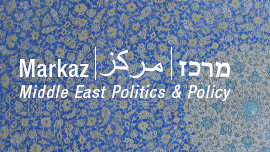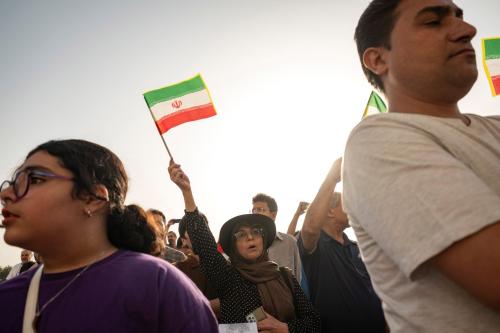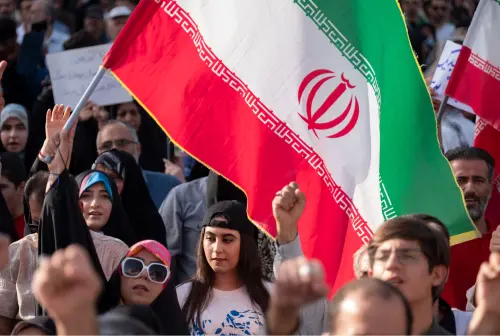Over recent weeks, Iran-watchers have been fixated – justifiably – on the domestic politics of the Islamic Republic, and their implications for the singular issue that has dominated Iran’s place in the world, the standoff with the international community over its nuclear program. And yet no one who is interested in Iran and the challenges its policies pose to international security can afford to overlook the regional context in which Iran’s presidential transition will unfold— a brutal civil war in Syria, in which Tehran is playing an increasingly central role, the often rocky and even violent path from autocracy to post-Arab Spring leadership in North Africa, and the shifts underway in the long stable Arab countries of the Persian Gulf.
Here at Iran @ Saban, Brookings scholars have offered thoughts on the role of Iran in U.S. policy toward Syria, and we expect to be returning to that issue again in the next few days. And this blog is a small part of a scholarly community that includes a host of highly-regarded experts weighing on issues across the region, including on Tunisia, Egypt, Libya, Yemen, Turkey and the broader Middle East and Islamic world. For today, however, it is fitting to spend a few moments considering recent events in the Gulf states and future propositions for U.S. policy toward the region.
Today, the Emir of Qatar, HRH Sheikh Hamad bin Khalifa al-Thani announced that he will cede power of the small, energy-rich state to fourth son, Sheikh Tamim bin Hamad al-Thani. The move has apparently been long in the works, and yet there is a real sense of uncertainty about what if any changes the 33-year-old new Emir will bring to Qatar’s activist agenda on regional security and global energy issues. Brookings has an office in Doha, and our director there, senior fellow Salman Shaikh, weighed in today with a commentary predicting continuity in Qatari foreign policy.
Shaikh’s analysis astutely notes that the fact:
“(t)hat the Royal Family has gone ahead with its plans in the midst of the Arab uprisings— and at such a critical time in the Syria crisis— is quintessentially Qatari. Big ideas and calculated risk-taking has got the country to where it is today.”
Also quintessentially Qatari has been the ability to navigate the American-Iranian fault line with unparalleled success. Doha plays a valuable role in American forward strategy in the Gulf, hosting the regional headquarters of U.S. Central Command at Al Udeid Air Base, and has lured immense sums of U.S. investment. And yet Qatar has also managed a pragmatic relationship with Iran that largely avoids the ideological and territorial feuds that have sustained friction between Tehran and the other Gulf heavyweights, Saudi Arabia and the United Arab Emirates.
And yet Qatar’s succession takes place amidst brewing conflicts across the region. Doha and Tehran are each massively engaged in the fight for Syria, supporting opposing sides in the conflict. At the time same, as Tehran has seen its oil revenues drastically reduced by international sanctions, Iranian officials have intensified their periodic complaints about relative depletion rates from shared fields, including Qatar’s crown jewel, the North Field non-associated gas reservoir, which is a shared geological structure with Iran’s own South Pars reservoir.
To date, these frictions appear to be held in check by regular dialogue among the two governments, including a May visit to Tehran by Sheikh Hamad bin Jassim Al Thani, the influential prime minister and foreign minister who is also rumored to be stepping down as part of the succession process. As they contend with their own leadership transition, Iranian officials initially appear to be playing their cards carefully toward Qatar, with a Foreign Ministry spokesman noting that “(w)e pursue the developments closely and wait to hear more details …Tranquility and stability in Qatar and other Persian Gulf littoral states is highly important to us.”
Meanwhile, elsewhere in the Gulf, the two-year-old uprising in Bahrain remains at a low simmer. Neither two years of protests and sporadically intense unrest by the Shi’a opposition, nor the concerted efforts of the minority Sunni government, with the aid of Saudi and Emirati forces, to conclusively end the uprising have prevailed. Iran looms large over the conflict within Bahrain, as a source of past terrorist activity and destabilization efforts, as the pretext for government crackdowns against the initially peaceful protests, as the rationale for Saudi determination to preclude any meaningful liberalization by the ruling Al Khalifa family, and as the wellspring of American ambivalence toward an authentic push for democratic reform in the region.
For Washington, of course, Bahrain has a special strategic importance, as the headquarters of the U.S. Navy’s Fifth Fleet and a vital base in the Gulf, one that is essential for deterring Iran. And yet the conflict in Bahrain has received relatively less attention in the Washington policy community precisely because the conflict appears intractable and U.S. presence there is so indispensable to America’s regional interests and allies. For this reason, I am especially pleased to have an opportunity to share an important new paper published this week by Brookings’ Center for 21st Century Security and Intelligence, entitled “No ‘Plan B’: U.S. Strategic Access in the Middle East and the Question of Bahrain.” The paper, written by Richard McDaniel, a U.S. Navy Commander and Federal Executive Fellow at Brookings 21CSI, offers a thoughtful consideration of the issues at stake for the U.S. military, and an important set of recommendations for American contingency planning.
I strongly urge anyone who is interested in Gulf security and U.S. policy toward Iran to read McDaniel’s paper in full here, but I want to highlight several key findings here. The paper highlights the absence of planning for alternative basing options in the Gulf, which is surprising given the endurance of unrest in Bahrain. McDaniel argues that the assumption that somehow Washington and/or Riyadh will keep the situation in check in Bahrain disregards the limitations to our control, noting the precedents (including pre-revolutionary Iran) in which similar assumptions have been upended to disastrous results. He points to the possibility that Saudi Arabia itself could experience rising levels of internal instability as compounding the need for contingency planning, and sees the alternatives to significant reform within Bahrain as repression or revolution, neither of which will facilitate a stable U.S. presence in the long term.
McDaniel offers valuable perspective on the significance of the U.S. relationship with Bahrain and the utility of the base there, and concludes with recommendations for a “Plan B” that would ensure continuity of U.S. presence and alliances if access to the naval base in Bahrain is lost. The paper offers a judicious path forward that may enable Washington to avoid any repeat of its past missteps, including in Iran, while continuing to facilitate the robust Gulf presence needed to address the challenges of the present, especially from Iran. At a time when America’s regional allies, such as Qatar, are embracing change and a proactive vision of the future, how can Washington be doing anything less?
The Brookings Institution is committed to quality, independence, and impact.
We are supported by a diverse array of funders. In line with our values and policies, each Brookings publication represents the sole views of its author(s).




Commentary
Bridging The Gulf? Iran And A Changing GCC
June 25, 2013